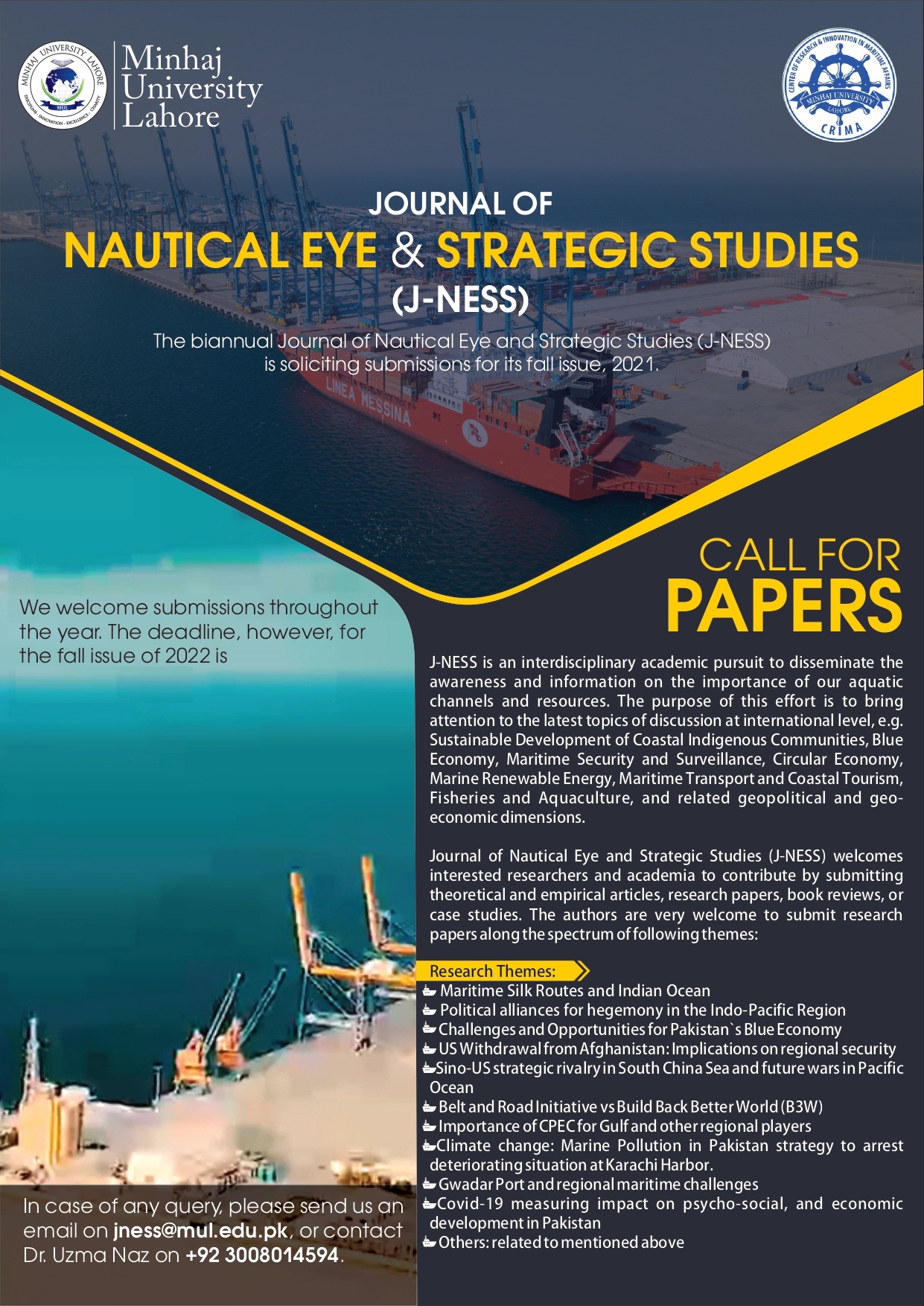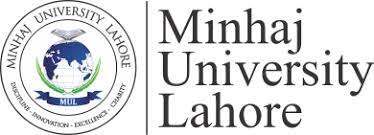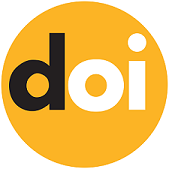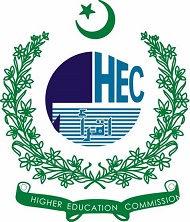Instructions for Author
Submission Guidelines
All manuscripts must be submitted electronically through the form available at our website Submissions | Journal of Nautical Eye and Strategic Studies (mul.edu.pk)
- Articles shall be in MS-Word (2013 or higher) duly formatted according to the guidelines and publication policy of the JNESS.
- Only Electronic submission (Soft Form) of manuscripts is accepted, and the corresponding text, tables, and figures shall be drafted in a single Microsoft Word file
- Manuscripts shall be submitted through our online forum at Submissions | Journal of Nautical Eye and Strategic Studies (mul.edu.pk)
- The Contributor have to register him/herself before submitting the Manuscript.
- In the event that a journal's editors are made aware of any allegation of research misconduct relating to a published article in their journal, the publisher or editor shall follow COPE's guidelines (or equivalent) in dealing with allegations.
Formatting Guidelines
- Title:The title of the article should be bold, centered and typed in capital letters (in 13 point) Times New Roman Font.
- Author(s) Details:These author(s) details should be in (10 point) Times New Roman Font and should be centered below the title.
- Full Name
- Designation
- Name of the Organization
- City
- State
- Country &
- E-mail ID.
- Abstract:All manuscripts must be accompanied by a brief abstract. Abstract should not exceed 150 words. It should be properly formatted as justified in italicized text in Times New Roman Font (9 point). It should highlight Research Background, Methodology, Major Finding(s) and Conclusion in brief.
- Key Words:Authors must mention 5-10 key words. Key words should be listed alphabetically, separated by commas, and full stop at the end.
- Page Setup:Size of the page should have 7 inches Width and 9.5 inches Height with 1- inch margin on all four sides. Header and Footer Layout should be 0.5 inches from edge.
- Manuscript:Manuscripts must in between 4000 – 7000 words (all inclusive). It should be 1.0 line spaced, Times New Roman font, 10 point with. Utmost care should be taken to avoid any spelling or grammatical errors (it is advised to get your draft reviewed from an English language expert before submission)
- Tables and Figures/Images:All important tables and figures/images should be incorporated into the body of the paper. Heading of the Table should be in Times New Roman, Bold, 10 Points and 0.25 inches indent (Left). Heading of the Figure/Images Should also be of the same specifications as Tables but below the Image/Figure and Centrally Aligned.
- References:All references should be listed alphabetically at end of the article using APA reference style only.
- Author(s) Biography:Every author must submit a brief biography, a photograph along with the Copyright Agreement form.
Manuscript Preparation
Ø Language
Manuscripts should be typed in MS Word, in English language and should be furnished online only via e-mail (in attachment).
Ø Length of Paper
The length of the paper should not exceed the maximum limit of the words i.e. 6000 words (Minimum 4000 Words). Paper containing more than 6000 words will be returned to the author(s) for abridgement. Articles should be typed in double-space (including footnotes and references) on one side of the paper only (preferably A4) with wide margins. Authors are urged to write as concisely as possible, but not at the expense of clarity.
Ø Instructions about Title Page
The title page is generally a separate page and comes before the text of the manuscript. It should include following details in the given sequence:
Ø Title
Title of your work should be very concise and meaningful, explicitly covering the contents of the paper because titles are often used to search the required contents by the users so avoid using formulas, abbreviations and jargons where possible.
Ø Author(s) Name and Affiliation
Author(s) name should be written clearly along with family name. Right below the author name, mention authors’ affiliation & address i.e. where the actual work was done. Indicate all affiliations with a lower-case superscript letter immediately after the author's name and in front of the appropriate address. Also should be included in this part the full postal addresses of authors’ each affiliation which include city and country name, and, if available, the e-mail address, and telephone number of each author.
Ø Corresponding Author
Clearly indicate who is willing to handle correspondence at all stages of refereeing, publication and also post-publication. Ensure that telephone numbers (with country and area code) are provided in addition to the e-mail address and the complete postal address.
Ø Sponsoring Information
If the submitted research work is sponsored or supported in any way by an organization or an NGO, please mention it clearly.
Ø Abstract
Your research work should be accompanied by an abstract which should not exceed 150 words. This abstract should entail the purpose of the study, methodology employed and findings of the study. Abstracts are often presented separate from the article / manuscript so it must be written in a way that it is able to stand alone.
Ø Keywords
Right after the abstract, write down a maximum of 5-10 keywords. Try to avoid general and plural terms and multiple concepts (avoid, for instance, ‘and’, ‘of’). Be very careful while using abbreviations in keywords; use only those abbreviations which are resolutely recognized in the field of study.
Ø Subdivision of the Manuscript
Authors are hereby advised to clearly divide their articles / manuscripts into defined and numbered sections. Sub-sections should also be numbered like 1., 2., (then 1.1, 1.1.1, 1.1.2), 1.2, etc. (except the abstract which is not included in section numbering).
Ø Figure Legends, Figures and Schemes
Authors should include these, in this sequence, at the end of their articles / manuscripts. The files having high-resolution graphics must be provided separate from the main body of the article / manuscript.
Ø Tables
Tables should also be presented at the end of the article. Kindly note that tables should be numbered one after the other according to their appearance in the text. Description of the tables should be presented right above the body of the table. Do not convert Tables into images before incorporating. Where possible, avoid vertical rules. Kindly make sure that data presented in the table do not duplicate the results presented in the manuscript elsewhere.
Ø Formula
The text size of the formula, if any, should be similar to the normal text size of the manuscript.
Ø References
It is the sole responsibility of the authors to be sure of the accuracy of bibliographic citations following the latest edition of APA.
Ø Citations in the Text
Kindly make sure that every reference cited in the text should also be presented in the reference list and vice versa. Authors should avoid using citations in the abstract of the manuscript. Personal communications and unpublished results should not be included in the reference list at the end of the manuscript but may be presented in the text. ‘In Press’ articles’ citation of a reference means that the work has been accepted for publication somewhere.
Ø Citing and Listing of Web References
Wherever an author faces a problem of citation of a web reference, please include the full URL as a minimum. Any other information, if known to the author, should also be presented. This information may be about the author names, dates and reference to a source publication etc. For convenience of the authors and readers, web references can also be listed separately (for instance after the reference list) under the separate head if so desired by the author(s), or it can obviously be included in the reference list.
Ø Text in References
Authors are advised to follow the referencing style used by American Psychological Association (APA), 6th edition. They can refer to the Publication Manual of the American Psychological Association (APA), Sixth Edition, on http://www.apastyle.org/manual/index.aspx.
Ø References list
References at the end of the manuscript should be arranged in an alphabetical sequence at the first place and then further sorted chronologically if necessary. If there are more than one reference from the same author(s) in the same year then it must be identified using the letters “a”, “b”, “c”, etc., which is written right after the year of publication.
Note:
Editor reserves the right to amend, abridge or otherwise alter the contents of the paper to make it suitable for publication. However every endeavor will be made not to affect the spirit or effectiveness of the paper.









